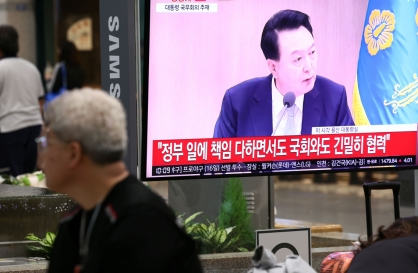[Kim Myong-sik] Better way to relieve old refugees’ pain
By Kim Myong-sikPublished : Aug. 29, 2018 - 17:13
 One advantage from living on the lower Han River northwest of Seoul is easy access to North Korea. Not that I have any private intelligence mission on the North, but I love to look at the riverside villages, low hills and paddy fields over there from the observatories established on this side of the river.
One advantage from living on the lower Han River northwest of Seoul is easy access to North Korea. Not that I have any private intelligence mission on the North, but I love to look at the riverside villages, low hills and paddy fields over there from the observatories established on this side of the river.
Standing at the Aegibong peak, the cliffs of Ganghwado and Gyodongdo islands or Odusan Hill of Paju, I fantasize of adding just one more bridge to so many existing ones over the Hangang to reach Gaepung County in the North. How nice would it be if an old North Korean refugee could get their exit and entry visas stamped at checkpoints on the bridge and walk over to the North to spend one or two days with their relatives before returning home?
One afternoon last week, I was in the coffee lounge at the top floor of the Odusan Unification Observatory, which was recently renovated to serve as a fine tourist facility. From the spacious hall with a 360-degree view, visitors can see the magnificent converging of the Han, Imjin and Yeseong rivers to flow into the West Sea.
Typhoon Soulik was passing through the Korean Peninsula that day and a few hundred people from South and North Korea were having a family reunion event at the Kumgangsan Resort 300 kilometers to the east, just north of the border. The media reported a first meeting between an 88-year-old man from the North and his 67-year-old son from the South who was born after the father left home during the Korean War.
This time, there were no husband-wife reunions. Officials said there were no applications from couples surviving separately in the North and South. Out of 130,000 who had registered with the South Korean Red Cross society in 2000 for reunions with family members in the North, more than 70,000 have died. Only about 2,000 among the survivors have had the great luck of being selected, randomly, to meet their North Korean family members and relatives through the 21 reunion events to date.
Let us ponder what a tight border we have had on this peninsula, which allowed just 2,000 people from the South to cross it in so many years to meet their spouses, parents and children in the North, or an average of 100 per a reunion event. Each time, Seoul had to entreat the Pyongyang authorities to get their consent, which they granted as if it were charity.
The legacy of the division of the country and the three-year war that ravaged it was too dark and cruel especially for the people in divided families. Battle lines moved up and down the entire length of the country in a matter of months in the early stage of the war, causing millions of refugees. Homes were destroyed and families that survived were dispersed.
When the two Koreas started discussing family reunions in the 1970s, they spoke of reuniting the “10 million people of separated families.” Pyongyang’s negotiators had initially called for “free visits” across the border, setting no restrictions on the number of separated families to be admitted to the other side. The North’s bold initiative was their propaganda ploy to try to take advantage of the still weak economic foundations and repressive political system of the South.
Early contacts were abortive, as both sides could expect little in the way of a profitable outcome from the exchange, while both Seoul and Pyongyang required internal consolidations of power. The rise of the South was remarkable in the following years, and when dialogue resumed in the mid-1980s, Pyongyang insisted on just 150 people for exchange visits, including large “cultural troupes.”
The normalization of diplomatic relations between Seoul and Beijing in 1992 created a new avenue of human transit between the two Koreas. The number of North Korean refugees arriving in the South via China and third countries grew rapidly in the 21st century to an aggregate of 30,000 at present. Meanwhile, thousands of South Koreans visited the North annually on economic and cultural programs under the Kim Dae-jung and Roh Moo-hyun administrations’ engagement policy toward the North.
A significant opening was made in the border in 1998 when South Korean tourists were admitted to Kumgangsan Resort for the first time. Since then the occasional family reunion events have also used the same mountain venue. The civilian tourism program was halted in 2008, however, after a visitor was shot dead by a North Korean guard.
And here we are, again watching the sad sights of a small number of people in their 80s or 90s unable even to express their natural sentiments properly during the long-awaited time of reunion. Social concerns are inevitably declining about the repetition of “the meeting to be parted again.” What is truly necessary to support those who are succumbing to physical and mental infirmity with the advancement of age is arranging quiet reunions at a permanent meeting place to be hopefully established in the border town of Kaesong or Kumgangsan.
By now, North Koreans must know well that extreme restriction of family reunions all these years has only exposed to the world community what a closed and controlled society the regime has maintained. It reveals that they are suffering acute paranoia from a long history of siege complex. Healing from it is a priority task of Pyongyang if they seek to become a normal state.
Kim Jong-un’s goal seems to be raising the standard of living for his people by spurring development of both manufacturing and consumer industries with concentrated investments of assets shifted from arms projects while securing maximum technological and financial aid from outside in exchange for a halt of nuclear and missile programs. Well, it’s OK, but he should be taught that no venture is without risk.
The North’s leader, who would least want to lose the current opportunity of having a government in Seoul willing to work with it, had better accept operating a reunion center for separated families in the South and North. It could serve as a useful contact point between the two Koreas.
If a few hundred more elderly refugees are given the opportunity of seeing their relatives in another reunion event this year, it would just be a small change in the statistics, again causing great disappointment to so many others.
Kim Myong-sik
Kim Myong-sik is a former editorial writer for The Korea Herald. – Ed.






![[From the Scene] Monks, Buddhists hail return of remains of Buddhas](http://res.heraldm.com/phpwas/restmb_idxmake.php?idx=644&simg=/content/image/2024/04/19/20240419050617_0.jpg&u=20240419175937)







![[From the Scene] Monks, Buddhists hail return of remains of Buddhas](http://res.heraldm.com/phpwas/restmb_idxmake.php?idx=652&simg=/content/image/2024/04/19/20240419050617_0.jpg&u=20240419175937)

![[KH Explains] Hyundai's full hybrid edge to pay off amid slow transition to pure EVs](http://res.heraldm.com/phpwas/restmb_idxmake.php?idx=652&simg=/content/image/2024/04/18/20240418050645_0.jpg&u=20240419100350)

![[Today’s K-pop] Illit drops debut single remix](http://res.heraldm.com/phpwas/restmb_idxmake.php?idx=642&simg=/content/image/2024/04/19/20240419050612_0.jpg&u=)